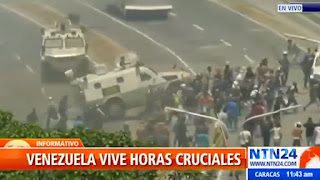The 'Idea' of Latin America
So, why are citizens of the United
States called “Americans” but citizens of Colombia, or Costa Rica are not? What
happened to Jose Marti’s idea of “Nuestro America” as one new American
Continent composed of numerous nations and speaking a variety of languages?
A change in the perception of the
identity of people living south of the border with the United States began in
the nineteenth century. This coincided with Spain’s decline and the growing
power of the United States. According to Walter Mignolo, Spain “missed the
train” of modernity and was in economic and political decline and Creole elites
looked instead to France as the idea in politics and literary culture.[i]
Writers and intellectuals in several
Spanish-speaking countries such as Colombia and Mexico were searching for a viable
alternative identity which would permit them to resist the encroachments of
Anglo-Saxon, Protestant America. La
Hispanidad (Hispanic identity) was the traditional identity for Creole
elites in Spanish America and implied a commitment to Catholicism, traditional
monarchy and a heritage that could be traced back to the glory days of Spain.
Several intellectuals suggested a
new conservative identity rooted in la
Latinidad (Latin identity) which represented an attempt to incorporate
French heritage (also Catholic and Monarchical) as part of a broader Latin (Spanish,
Portuguese and French) heritage and identity. Serendipitously, this also
coincided with geo-political developments in Europe. France was rising to
political and military dominance once again, this time the rule of emperor Napoleon
III, and was interested in projecting her imperial power into the Americas.
(Left: Benito Juarez, President of Mexico) After Conservatives lost a brief
but severe civil war in Mexico to the Liberals under the leadership of Benito
Juarez. The beaten Conservatives invited France to intervene in Mexican
politics by sending French troops and setting up a monarchy Archduke
Maximillian of Austria, something France was eager to do. The moment was
propitious with the United States occupied in its own Civil War and unable to
enforce the Monroe Doctrine. Maximillian accepted an offer from Mexican
Conservatives to become Emperor of Mexico in 1863, falsely believing that the
Mexican people had voted to accept his reign. Unfortunately, when the U.S.
Civil War ended in 1865, the French troops were forced to depart the Americas
and Maximillian was captured and shot, despite his liberalism and benevolence.
(RIGHT: Maximillian, Emperor of Mexico)
(RIGHT: Maximillian, Emperor of Mexico)
From the middle of the nineteenth
century, intellectual elites began to use the term Latin American to indicate their identity with Southern and
Catholic Europe and to express their opposition to Protestant Anglo-America.
Walter D. Mignolo notes in this book, The Idea of Latin America that in 1856,
Colombian intellectual Jose Maria Torres Caicido used the phrase Latin America in a poem “Two Americas.” The
term was used the same year in Paris at a conference by a Chilean Francisco
Bilbao. Also, the term “Latino” was
intended to broaden the base of Latin America by allowing the incorporation of
Brazil into the club, even though Brazilians were decisively NOT Hispanics.
In the Iberian ex-colonies, the
idea of Latin America emerged as a consequence of conflicts between imperial
nations. This “idea” was needed by France to justify its conflict with the U.S.
for influence in the South of the Americas. It was also needed by creole elites
in Spanish America to defend their identity against the growing hegemonic
threat of Anglo America. Latin America is not so much a sub-continent as it was
a political project; it simultaneously lifted up the Spanish creole elites and
erased the identities of the Indian and African populations (who were not
Latino).
With the invention of “LATIN”
America, the American continent became two continents instead of one. According
to some theoretical perspectives, the partition the new continent of America,
into North and South, American and Latin
American also served the purpose of marginalizing Latin American nations as a
neo-colonial periphery to a new, emerging industrial and commercial center of
global capitalism in the United States. Colombians, Mexicans and Peruvians were
no longer “Americanos.” They were Latino
Americanos, although even that might be disputed by some indigenous or
Afro-latino residents of South America because of its close association with
Southern, Catholic Europe.
So, by the early twentieth century,
there was now a Latin, Catholic and Spanish-Portuguese speaking civilization in
South America, and an Anglo-Saxon, Protestant English speaking society in the
North. The Latin Americans had fallen behind the Gringos and were now part of
the neo-colonial periphery of norte America. When the dictator of Mexico fled into exile in 1910, he supposedly
wisely observed, “Pobre de México, tan
cerquita a los estados unidos y tan lejos de Dios.”
Globally, there were now 5
continents instead of three.
Today, there is a debate about
whether there are six or seven continents (including Australia and the Pacific
Islands and Antarctica) or Europe and Asia should be combined into one super
continent, EURASIA. But there is no debate that Americanos are the citizens of
the United States. In naming the continents, Noah’s sons have been long
forgotten.




I enjoyed learning about the perception of identity between those who live in the U.S and define themselves as 'Americans' and those who live in south America and are defined as Latins because of the Spanish language.
ReplyDeleteNever thought about this way. Pretty Cool
ReplyDeleteGabriel Sierra